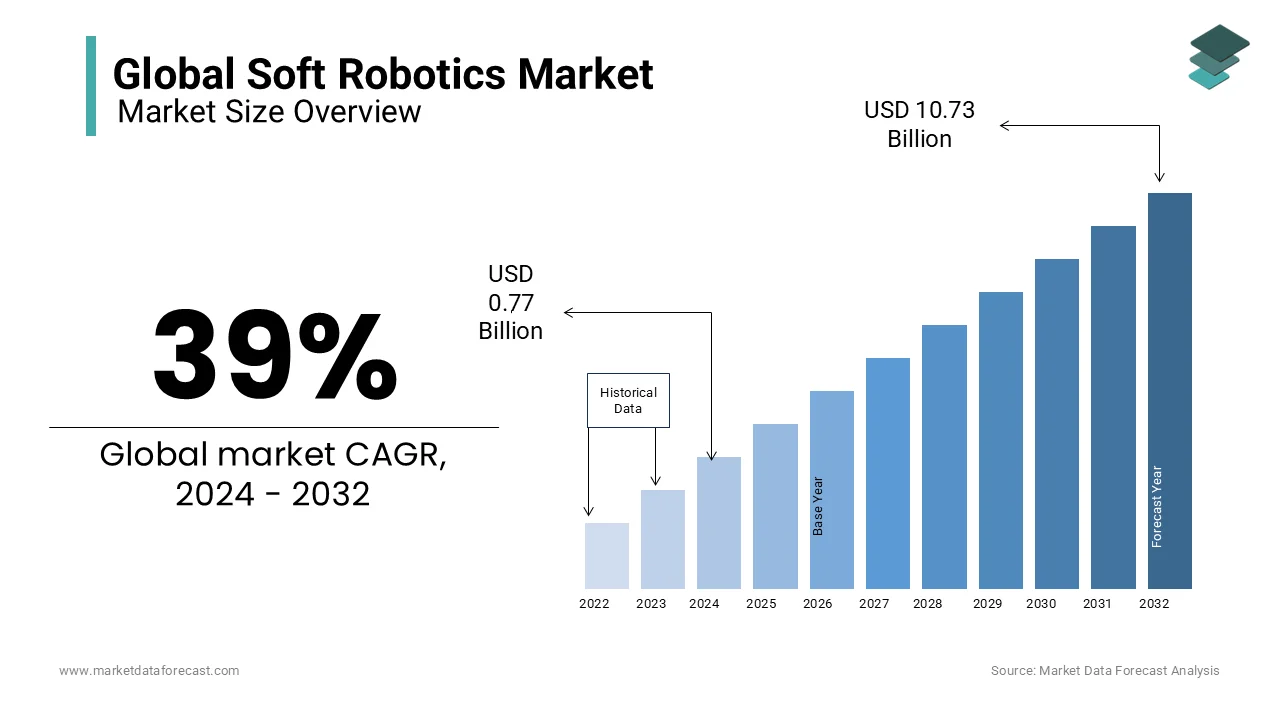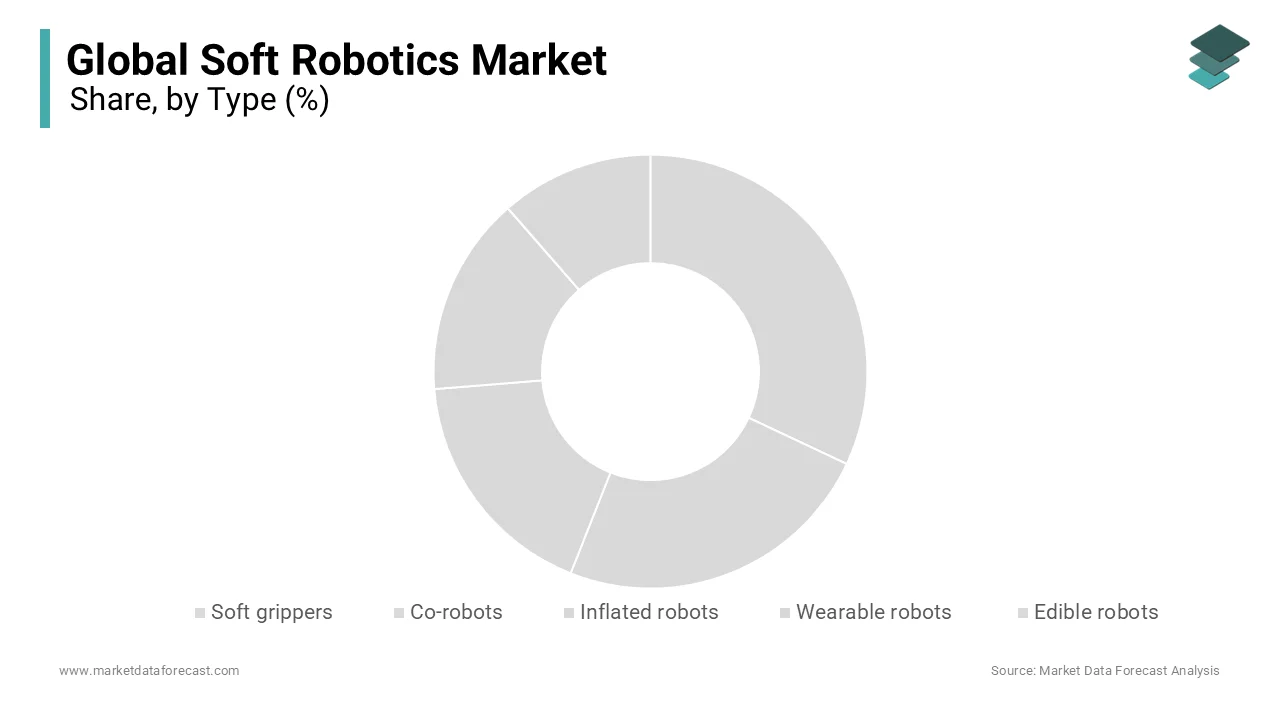Global Soft Robotics Market Size, Share, Trends, & Growth Forecast Report - Segmented By Type (Soft grippers, Co-robots, Inflated robots, Wearable robots, Edible robots, Others), Application (Medical and Healthcare, Food and Beverages, Logistics, Entertainment & Gaming, Automotive, Survey & Exploration, Others), & Region - Industry Forecast From 2024 to 2032
Global Soft Robotics Market Size (2024 to 2032)
The size of the global soft robotics market was worth USD 0.55 billion in 2023. The global market is expected to be worth USD 0.77 billion in 2024 and USD 10.73 billion by 2032, growing at a CAGR of 39% during the forecast period.

Soft robotics is a subfield of specially developed construction robots that provides a reprogrammable, versatile and versatile system that is intelligently linked to sensor behaviour. In addition, soft robotics vendors design materials, components, and huge active structures in a way that is safer in the manufacturing process and better adapted to the environment more directly than hard component robots.
Soft robotics technology can potentially eliminate the complexity of mechanical and algorithmic robot design. In addition, soft robotics can combine tissue engineering to produce hybrid systems used in medical applications. In addition, soft robotics can be divided into robot grippers, inner robots, etc., depending on the application of robotics.
MARKET DRIVERS
The main drivers of the software robot market are the continuous improvement of automation in the food and beverage industry and the continuous expansion of research and development in the robot industry.
Despite the pandemic issue, governments around the world have launched a series of R & D programs to promote the importance of robotic systems to industries around the world. Similarly, rising healthcare prices offer ample growth potential for the soft robotics market. Soft robots have unique advantages that make them ideal for use in humans and living tissues. Some of the areas of research in which soft robotics are most likely to be used are minimally invasive surgery (MIS). This is because it overcomes the shortcomings of traditional MIS approaches, such as limited flexibility.
Furthermore, the growing demand for automation and human safety in manufacturing units may propel the Soft Robotics market forward. Exoskeletons are a novel type of protective equipment that can protect warehouse and industrial workers from back, neck, and spine injuries caused by heavy, repetitive weight lifting.
MARKET RESTRAINTS
Capital investment in robots, on the other hand, is expected to be a major market constraint, limiting expected growth over the projection period. The cost of obtaining market goods and services is high, limiting the ability of entrepreneurs and small businesses to reap market benefits and improve their quality and efficiency throughout the forecast period.
REPORT COVERAGE
|
REPORT METRIC |
DETAILS |
|
Market Size Available |
2023 to 2032 |
|
Base Year |
2023 |
|
Forecast Period |
2024 to 2032 |
|
CAGR |
39% |
|
Segments Covered |
By Type, Application and Region |
|
Various Analyses Covered |
Global, Regional & Country Level Analysis, Segment-Level Analysis, DROC, PESTLE Analysis, Porter’s Five Forces Analysis, Competitive Landscape, Analyst Overview on Investment Opportunities |
|
Regions Covered |
North America, Europe, APAC, Latin America, Middle East & Africa |
|
Market Leaders Profiled |
KAWADA Robotics Corporation, F&P Robotics AG, Ekso Bionics Holdings, Inc, Soft Robotics Inc, RightHand Robotics Inc, ReWalk Robotics Ltd, Rethink Robotics, Kawasaki, Yaskawa Electric Corporation, AUBO Robotics Inc and Others. |
SEGMENTAL ANALYSIS
Global Soft Robotics Market Analysis By Type

Based on type, the market is divided into soft grippers, co-robots, inflatable robots, wearable robots, edible robots and so on. The wearable robot segment is expected to drive market growth. Wearable robots are widely accepted in the healthcare and packaging industry for automating processes.
Global Soft Robotics Market Analysis By Application
Based on application, the market is divided into Health & Healthcare, Food & Beverages, Logistics, Entertainment & Games, Automotive, Research & Exploration, and more. Medical and healthcare are projected to be the fastest growing markets in the forecast period. Soft robots have the unique advantage of being compatible with the natural tissues of humans and living organisms. Minimally invasive surgery (MIS) is one of the areas of research with great potential for the use of soft robotics.
REGIONAL ANALYSIS

On the basis of Geography, North America will dominate the global soft robotics market with a forecast period. North America is anticipated to hold the largest market share. Increasing per capita wealth in the United States has led to increased demand for both durable and durable consumer goods, emphasizing the need for safe and efficient manufacturing methods. As a result, companies that produce both durable and non-durable consumer goods are gradually incorporating larger assembly lines into their production processes to meet the demand for those products.
The enlargement of warehousing and distribution hubs is likewise important. According to the United States Commerce Department, net income accounted for 11.3 % of normal retail income, a boom from 10.9 %previously. This will boom the call for warehouse control to enhance efficiency, consequently growing room for the researched marketplace. So, this principal issue will force the boom of this location withinside the international Soft Robotics marketplace at some point of the forecast period.
KEY MARKET PLAYERS
Major Key Players in the Global Soft Robotics Market are KAWADA Robotics Corporation, F&P Robotics AG, Ekso Bionics Holdings, Inc, Soft Robotics Inc, RightHand Robotics Inc, ReWalk Robotics Ltd., Rethink Robotics, Kawasaki, Yaskawa Electric Corporation, AUBO Robotics Inc.
RECENT HAPPENINGS IN THE MARKET
-
Soft Robotics Adds New Features to the mGrip Modular Gripping System - Soft Robotics Inc. announced the expansion of the mGrip Modular Gripping System with new capabilities and an IP69K rating to enable safe protein and dairy product handling. These new features give machine builders more options for designing flexible end-of-arm tools that can withstand high-pressure washdown environments.
-
Righthand Robotics Displays the Next-Generation RightPickTM 3 Item-Handling Robot System at ProMatDX - Righthand Robotics, a pioneer in data-driven autonomous picking solutions for order fulfilment, introduces the RightPickTM 3 item-handling robot system, the latest generation of the award-winning RightPick product suite. The announcement coincides with this year's ProMatDX virtual material handling automation showcase.
DETAILED SEGMENTATION OF THE GLOBAL SOFT ROBOTICS MARKET INCLUDED IN THIS REPORT
This research report on the global soft robotics market has been segmented and sub-segmented based on the type, application, and region.
By Type
- Soft grippers
- Co-robots
- Inflated robots
- Wearable robots
- Edible robots
- Others
By Application
- Medical and Healthcare
- Food and Beverages
- Logistics
- Entertainment & Gaming
- Automotive
- Survey & Exploration
- Others
By Region
- North America
- Europe
- Asia Pacific
- Latin America
- Middle East and Africa
Frequently Asked Questions
What are the primary factors driving the growth of the soft robotics market globally?
Key drivers include advancements in material science, increasing demand for automation in industries like healthcare and logistics, and the growing need for robots that can safely interact with humans and delicate objects.
What are some common applications of soft robotics?
Soft robotics are commonly used in medical and surgical applications, logistics and warehouse automation, agriculture, and in the manufacturing of consumer electronics and food products.
What advancements in material science are influencing the soft robotics market?
Developments in materials such as silicone, elastomers, and shape-memory alloys are enabling the creation of more flexible, durable, and efficient soft robotic components.
What role do government policies and regulations play in the soft robotics market?
Government policies and regulations play a crucial role by providing funding for research, establishing safety standards, and promoting the adoption of robotics technology across various sectors through incentives and subsidies.
Related Reports
Access the study in MULTIPLE FORMATS
Purchase options starting from $ 2500
Didn’t find what you’re looking for?
TALK TO OUR ANALYST TEAM
Need something within your budget?
NO WORRIES! WE GOT YOU COVERED!
Call us on: +1 888 702 9696 (U.S Toll Free)
Write to us: [email protected]